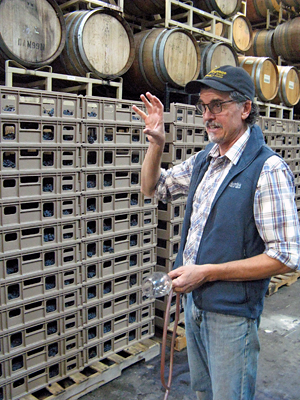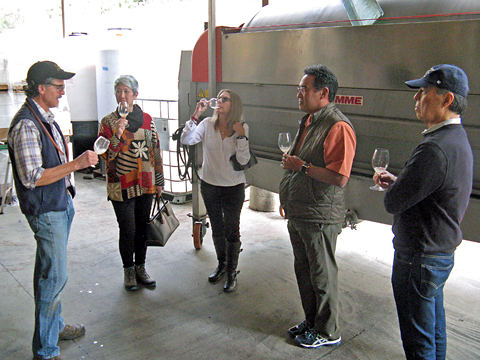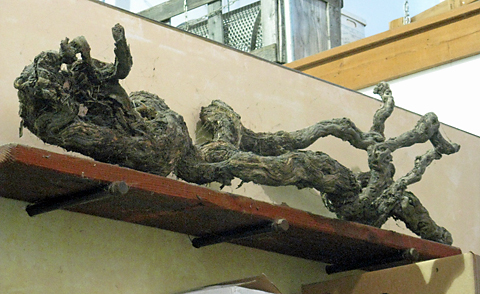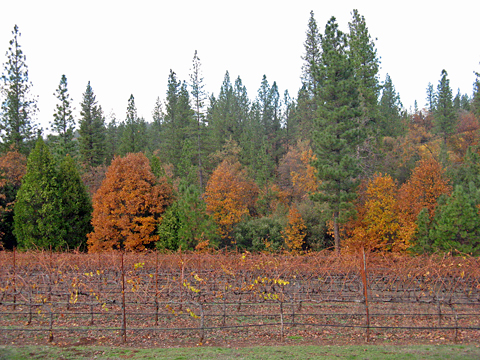Sierra Foothills Wine Visits – November 2017
I’ve posted a portion of a report on a late November visit with a few friends to three Sierra Foothills wineries and tasting rooms. A full report on all of the visits is on the Grape-Nutz.com website:
Sierra Foothills Visits – November 2017
Holly’s Hill Vineyards
Miraflores Winery
Cedarville Vineyard
It’s become a late-fall tradition for me to travel to the Sierra Foothills and visit wineries there with friends. It’s usually a one-day trip – a long day for me, coming from the Bay Area, but it’s always an enjoyable outing. I arranged to meet my friends Jane and Chris, who live in Sacramento, on the morning after Thanksgiving. Jane’s cousin Mike and his wife Carol were visiting for the holiday, and they were able to join us as well. While Jane has been along on a number of my Sierra Foothills wine trips, Chris had only been wine-tasting in the area once, and this would be Mike & Carol’s first time visiting wineries there. While it’s often fun to check out wineries that are new to me, I thought that this time it would be good to stick with some old favorites from the El Dorado County.
Miraflores Winery
I’ve visited Miraflores several times on my previous wine trips to El Dorado County, but I’d always missed seeing winemaker Marco Cappelli on the days when I stopped there. This time I was in luck! I’d contacted Marco earlier in the week and he responded that he would be at the winery that day, and that my friends and I should stop by for some barrel tasting. I was especially glad that I’d finally be able to meet Marco this time, since he had been amazingly generous in giving me advice via email and phone conversations on making a particular wine in 2015 – more on that below.
[resizeableimage=360,71]http://www.mirafloreswinery.com/wp-content/uploads/2017/02/miraflores_logo_text.png[/resizeableimage]
Marco has been the winemaker at Miraflores since their inaugural vintage in 2003. He became interested in winemaking while in college, and earned a degree in enology from UC Davis in 1984. Following this, he gained practical experience working for a year in Italy and six months in France before returning to California, taking a position at Saintsbury Winery in Carneros. There, he met legendary vintner André Tchelistcheff, who soon recommended Marco to Clarke Swanson, who was launching Swanson Vineyards in Napa Valley. Marco became the winemaker at Swanson – working with André Tchelistcheff’s guidance for the first few years – and he stayed there for 17 years before moving to the Sierra Foothills in 2004. He’s made many different wines through the years, but he has gained particular acclaim for his sweet wines and he’s widely-recognized as one of California’s top dessert wine specialists. In addition to his work at Miraflores, Marco consults for a number of other Sierra Foothills wineries.
Miraflores proprietor Victor Alvarez is a native of Colombia, where his family had a cattle ranch. Now a practicing pathologist in Yuma, Arizona, he purchased the 254-acre site a few miles east of Pleasant Valley in 1995. Just 40 acres are planted, and although there is room for further expansion in the future, the plan is to maintain most of the property in its natural state. Most of the vineyard was planted in 2000-01. Zinfandel and Petite Sirah are the largest plantings, and among the other varieties planted there are Chardonnay, Viognier, Muscat Canelli, Black Muscat, Barbera, Syrah, Mourvèdre, Tempranillo, Cabernet Sauvignon, Cabernet Franc, Malbec, and Petit Verdot. The estate vineyard ranges from about 2,500 feet to nearly 3,000 feet in elevation, and various elevations and exposures were selected for the different grape varieties. Noted El Dorado vineyard manager Rick Wickham, who grew up only a few miles from the winery, oversees the farming at the estate vineyard.
Chris and I both parked our cars by the Miraflores tasting room, located on a knoll overlooking part of their vineyard. From there, we walked down the hill to the winery building, where we soon found Marco along with his two young children. Marco welcomed us in, while one of his friends led his two kids up the hill for awhile. The winery was completed in 2007 – I mentioned to Marco that I’d tasted in that building when I first visited Miraflores with friends in 2008, before the current tasting room was finished in 2010. The winery building is fairly large, though the annual production of Miraflores wines is only about 4,000 cases. The balance of the 15-20,000 cases produced each year at the facility are from custom crush clients – Marco estimated that there are over 100 different wines being made at the facility for all the various labels.

Marco Cappelli
We followed Marco into a barrel room where he showed us racks of Tempranillo and Barbera grapes being dried to make an Amarone-style wine called “Tintoretto” – I later tried an earlier vintage of this wine back at the tasting room. Marco soon began pulling barrel samples for us to taste, starting with a couple of whites sourced from Indian Rock Vineyard, located just outside the town of Murphys in Calaveras County. Marco makes the Indian Rock Vineyards wines, and we tasted a number of samples destined for their wines, as well as a few for Langman Estate Winery – Marco is also the winemaker for that label. A sample of 2017 Vermentino, being fermented in a neutral barrel, had not yet finished fermentation and had lots of banana and tropical fruit aromas at this stage. A sample of 2017 Pinot Gris from the same vineyard was from a stainless steel tank, and this was more developed and quite nice, with apple and pear fruit and a chalky mineral texture.
Moving on to reds, Marco pulled a barrel sample of fresh berry-fruited 2017 Petite Sirah from Indian Rock Vineyard, followed by a very promising 2017 Syrah for Langman. Full of dark fruit, herbs, and black pepper, this was sourced from Baby Rattlesnake Vineyard in the Fair Play region. An herbal 2017 Malbec was next, and then a red-fruited and vibrant 2017 Barbera – both of those also for Langman. Marco shifted gears a little with a couple of 2016 barrel samples. We returned to an Indian Rock wine for the [/b]2016 Zinfandel[/b] from Cappelli Ranch. Marco bought that vineyard in 2002 – it was planted in the 1970s and is still labeled by some producers under its original name of Herbert Vineyard. This attractive darker-fruited and spicy Zin was co-fermented with 12% Petite Sirah. An earthy, plummy, and smoky 2016 Tempranillo sourced from Penn Valley in Nevada County, farther north in the Sierra Foothills, completed our barrel samples of dry wines.
Marco asked whether we would like to try some sweet wines – that was an easy decision for us to make! As mentioned above, Marco is especially noted for this type of wine. He told us that he likes making dessert wines because it’s fairly easy to do – though having made a couple of them myself, I’m not so sure that’s the case! We started with a real stunner – a 20-year old Tawny Port for Indian Rock. This had beautiful nutty and brown sugar aromas, with a rich, concentrated texture that can only come from years of barrel-aging.

I mentioned earlier that Marco had helped me greatly when I was planning to make a particular wine in 2015 – a Mission Angelica. Marco is unquestionably the master of making Angelica, a rare and somewhat obscure wine that’s a true California original. Traditionally made from the Mission grape variety – the first Vitis vinifera vines introduced to California – Angelica is fortified to about 18% alcohol with high-proof grape brandy, added before the grapes have even started to ferment or very shortly afterwards. Another tradition is that the wine is then left in barrel for a number of years with minimal topping or racking, allowing it to oxidize, not unlike a Tawny Port. I’d become interested in the historical nature of this wine in California – it was produced here at least as early as the 1830s and quite likely for some time before that – and decided to make an Angelica myself. I contacted Marco and he was extremely helpful in pointing me toward the source of some Mission grapes and in guiding me in the details of making the wine.
Knowing my particular interest in Angelica, Marco took us through a fascinating series of Miraflores barrel samples that helped in understanding the aging process that this wine undergoes. We tasted samples of 2017, 2016, 2013, 2006, and a non-vintage blend of Mission Angelica. Three of these were made from Mission grapes from well-known Rinaldi Vineyard in the Fiddletown area of Amador County, with vines that may date back to the 1860s. Even older are the Mission vines that Marco works with from Deaver Vineyard in Amador’s Shenandoah Valley, reputed to have been planted in 1853 – these may well be the oldest continuously-producing winegrape vines in California. Each successive Angelica barrel sample we tasted showed more oxidative Tawny-like character as well as greater concentration, along with brown sugar and caramel aromas and sweet plummy flavors. The non-vintage sample (with an average age of ten years) was my favorite, with the 2006 and 2013 vintages not far behind. Marco uses a solera-type system for the Angelica, with a “mother blend” of older wine used to top up barrels about once a year.
One final barrel sample was a 2016 Black Muscat, a variety not often seen in California. Another fortified wine, this displayed intense floral and lychee fruit aromas and sweet flavors, with a more structured mouthfeel than the Mission Angelica samples. This will be bottled much earlier than the Angelica to preserve its fresh and floral character, so it is not allowed to oxidize as with the Angelica.

We noticed a huge old Mission vine from Deaver Vineyard on a wall inside the winery. Marco told us that some of the remaining old vines there (still about four acres) are very tall, quite similar to old Mission vines I’ve seen in the Lodi area.
We said goodbye to Marco, and walked back up the hill to the tasting room to try a few of the current Miraflores releases there. The tasting room is a handsome Mediterranean-style building that features iron doors crafted in the 1800s, a stone floor, and huge recycled Douglas Fir roof beams that were originally part of the old Oakland Ferry Building, which was demolished in the 1930s. The spacious tasting room was busy on that Friday after Thanksgiving.
Miraflores regularly features around 20 wines that are available to taste, so it was tough to choose just a few since we had limited time until our next appointment. I started out with the 2015 Viognier, which was a good choice – ripe stone fruit and citrus with floral overtones and touches of earth and spice, with a rich yet lively texture. The fruit for the 2015 “Misión 1853” was sourced from the old Mission vines at Deaver Vineyard. Very light color for a red – typical of Mission – with red fruit and spice aromas. Next was the 2013 Mourvèdre – earthy and spicy with dark fruit and a touch of leather on the nose. I finished up with the 2012 “Tintoretto” Amarone-style wine – this vintage was made from Syrah, Petite Sirah, and Cabernet Sauvignon, dried on racks for three months before vinification. Ripe and slightly raisiny dark fruit and spice aromas with mildly sweet flavors and a rich texture – a style of wine not often seen in California and quite intriguing.
[resizeableimage=526,365]https://scontent-sea1-1.xx.fbcdn.net/v/t31.0-8/23916357_10209449896718955_5197347819608732169_o.jpg?oh=4caf7a9d3d55f026e84e030c05687488&oe=5A8B2911[/resizeableimage]
Other wines that Miraflores produces include Pinot Grigio, Chardonnay, Muscat Canelli, Grenache, Syrah, Zinfandel, Malbec, Petite Sirah, Cabernet Sauvignon, Meritage, Barbera, Tempranillo, and more, plus a number of sweet wines, both fortified and botrytis-affected – quite a list! Most of these wines were available for tasting the day of our visit. Prices are very reasonable for the quality, with whites priced at $18-$26, reds mostly around $30, while a few reserve bottlings and the sweet wines are higher. I should note that several of the dessert wines come in distinctive and beautiful bottles, which customers can bring back to the winery to be refilled for a discounted price.
This was a particularly memorable visit to Miraflores, as it was great to finally meet Marco and we had a wonderful time tasting barrel samples with him. He’s much younger than you’d expect for someone who’s been a winemaker for as long as he has, and he still has a sort of youthful enthusiasm to his manner. Many of the barrel samples we tasted showed a lot of potential, with favorites including the 2017 Pinot Gris, 2017 Syrah, 2017 Barbera, and 2016 Zinfandel…and just about all of the sweet wines we tried! If I had to choose, I thought the 20-year old Tawny Port, non-vintage Angelica, and 2016 Black Muscat were highlights among these. And though I only had time to taste four of the current Miraflores releases, the 2015 Viognier and 2012 “Tintoretto” were standouts. Miraflores produces a diverse selection of wines, and the best of them are certainly among the finest I’ve tried from El Dorado County – definitely worth a visit there.

Although I often try to pick one or two wineries that are fairly new to me on my Sierra Foothills wine tours, this time I stuck with three tried-and-true producers. I thought this would be a good introduction to the region for my friends who had little or no experience with the wineries from the area, and they all enjoyed the wines we tried from Holly’s Hill, Miraflores, and Cedarville. The focus and style of each of these three are distinct, and they all do a fine job of presenting a line-up of wines that showcase their vineyards and winemaking.
A visit to El Dorado County wineries makes for a long and somewhat tiring day for me, but I always enjoy it. There’s an atmosphere that’s truly welcoming there, something that you don’t find nearly as much in other California wine regions these days. And as I found once again, the better producers from the area offer great value for the quality of their wines in comparison to those from many other parts of the state. Along the way on this trip, I heard about a couple of other wineries I’d like to check out the next time I visit El Dorado, so I’m already looking forward to that. As always, thanks to everyone that we visited for being so generous with their time and their wine!
[resizeableimage=540,560]http://www.grape-nutz.com/kenz/images/el-dorado-wine-region-map.jpg[/resizeableimage]
Map courtesy of: El Dorado Winery Association (eldoradowines.org)